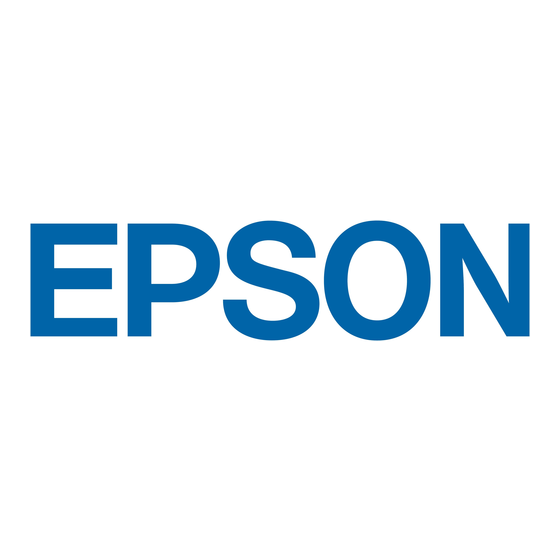
Table of Contents
Advertisement
Quick Links
Advertisement
Table of Contents

Subscribe to Our Youtube Channel
Summary of Contents for Epson C82303/09 (Parallel I/F
- Page 1 32KB Parallel Interface...
- Page 2 EPSON OVERSEAS MARKETING LOCATIONS EPSON AMERICA. INC. E P S O N D E U T S C H L A N D G m b H ZUlpicher Stra6e 6. 4000 2780 Lomita Blvd.. OUsseldarf 11 Torrance, Calif. 90505. U.S.A F.R.
- Page 3 FCC for this equipment. If this equipment has more than one intertace connector. do not leave cables connected to unused interfaces. Seiko Epson Corporation shall not be liable against any damages or problems arising from the use of any options or any consumable products other than those designated as Original Epson Products or Epson Approved Products by Seiko Epson Corporation.
- Page 4 32KB Parallel Interface 32-KB-Schnittstellenkarte Interface parallsle 32Ko Interface en paralelo de 32KB Interfaccia parallela da 32 KB...
-
Page 5: Table Of Contents
TABLE OF CONTENTS INTRODUCTION About this guide SETTING THE CONDITIONS Board layout DIP switch settings Jumpers Jumper settings DATA ENTRY About data entry SELF TEST SPECIFICATIONS HARDWARE DESCRIPTION INSTALLATION FX, FX+ LX-80/86 LQ-800/1000... -
Page 6: About This Guide
About this guide This guide is designed to give you detailed information on how to install your C82303* interface board in a variety of Epson printers. procedures vary slightly depend- Installation ing upon the printer model that you have. Also included, are instructions on how to adjust the settings of the C82303* interface board, as well as a general description of parallel data communication. -
Page 7: Setting The Conditions
SETTING THE CONDITIONS The C82303* interface board has a set of DIP (Dual In-line Package) switches, and 6 jumpers. This switch and jumpers are used for selecting various interface operations. Board layout The diagram below shows the layout of the C82303* board, and the locations of the DIP switch and jumpers. -
Page 8: Dip Switch Settings
DIP switch settings Before you install the C82303* interface, you may need to adjust some of the settings. When making DIP switch setting changes, it is best to use a pointed device, such as a ball-point or small screwdriver. Caution All changes of DIP switch and jumper settings should be made with the printer power turned off. -
Page 9: Jumpers
DIP switch 1 The table below contains information on switch functions, and the factory setting of each switch. The switches on DIP switch 1 allow you to change interface functions. Table 1. DIP switch 1 ( ON 1 Off ( Factory setting ) 1 SW pin No.1 Function I/F board enable/disable... -
Page 10: Jumper Settings
Jumper settings The tables below give you information about the interface conditions that can be selected using jumpers. In all cases, ON denotes the connection of the jumper (covering both termi- nals), while OFF denotes the disconnection of the jumper. Table 2. - Page 11 Table 3. Data latch timing selection Jumper Factory Setting Function * ON Falling edge of OFF Rising edge of B OFF STROBE ON STROBE Note Either J4A or J4B jumper must be connected.
-
Page 12: Data Entry
DATA ENTRY About data entry To accommodate data entry, the C82303* interface board is equipped with a buffer that temporarily stores data before transferring it to the printer. When this buffer becomes full, any additional transmitted data cannot be accepted discarded. -
Page 13: Self Test
SELF TEST The self test mode can be set by the DIP switch 1-3. To set, first turn off the power to the printer and then change the DIP switch setting. When the power is turned back on, the new setting automatically comes into effect. -
Page 14: Specifications
SPECIFICATIONS S-bit parallel Data transmission: External supplied STROBE pulse 2. Synchronization: Via ACKNLG or BUSY signals 3. Handshaking: TTL level Logic level: 32K bytes 5. RAM capacity: 57-30360 (Amphenol), 36 pin or its 6. Connector: equivalents . Interface timing The figure below shows the timing for the parallel interface. Figure 3. -
Page 15: Hardware Description
HARDWARE DESCRIPTION For signal description and pin assignment, refer to the table below: Table 5. Signal description and pin assignment Signal Description Ike&on Signal STROBE pulse to read data. Pulse YimiE width be more than 0.5 micro- must terminal. seconds at the receiving These signals represent information DATA 1 of the 1st to 8th bits of parallel data,... - Page 17 Note The column heading “Direction” refers to the direction of signal flow as viewed from the printer. All interface conditions are based on TTL level. Both the rise and fall of each signal must be less than 0.2 KS.
- Page 18 NOILV-IWLSNI ‘Xii +xiI...
- Page 19 98/08-X1 000T/008-iTI...









Need help?
Do you have a question about the C82303/09 (Parallel I/F and is the answer not in the manual?
Questions and answers